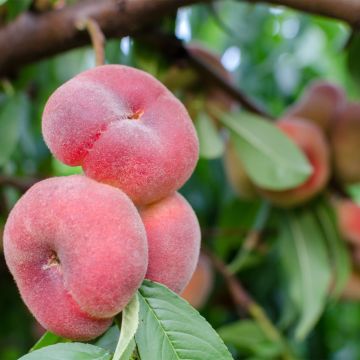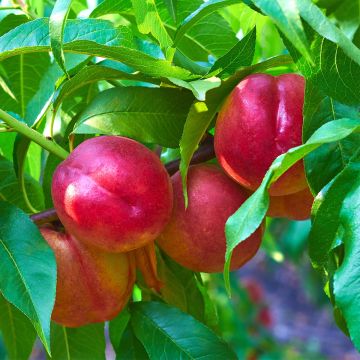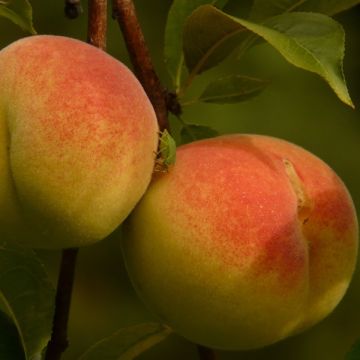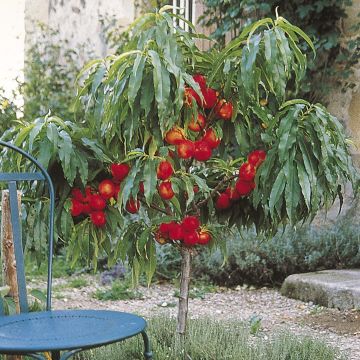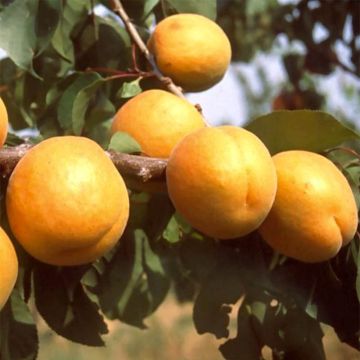

Prunus persica Diamond Zaipevi - Dwarf Peach


Prunus persica Diamond Zaipevi - Dwarf Peach
Prunus persica Diamond Zaipevi - Dwarf Peach
Prunus persica Diamond® Zaipevi
Peach, Peach tree
I received my dwarf fruit trees just 5 days after placing my order (including a weekend). Very satisfied because my plants are beautiful and extremely well protected, so there's no way the soil could spill out of the pot as mentioned in previous comments. I would recommend without hesitation and will suggest this website to my friends.
GENEviève, 22/10/2025
Special offer!
Receive a €20 voucher for any order over €90 (excluding delivery costs, credit notes, and plastic-free options)!
1- Add your favorite plants to your cart.
2- Once you have reached €90, confirm your order (you can even choose the delivery date!).
3- As soon as your order is shipped, you will receive an email containing your voucher code, valid for 3 months (90 days).
Your voucher is unique and can only be used once, for any order with a minimum value of €20, excluding delivery costs.
Can be combined with other current offers, non-divisible and non-refundable.
Home or relay delivery (depending on size and destination)
Schedule delivery date,
and select date in basket
This plant carries a 6 months recovery warranty
More information
We guarantee the quality of our plants for a full growing cycle, and will replace at our expense any plant that fails to recover under normal climatic and planting conditions.

Description
The Diamond® Zaipevi Dwarf Peach is a self-fertile variety. A small tree, its red fruits are as large as others, about 7 cm (3in) in diameter. Their white flesh is melting and fragrant, very sweet. Harvest takes place at ripeness, at the end of July.
The species name "Persica" was given to the peach, which was believed to originate from Persia. In reality, all cultivated forms originate from northern China. Its appearance in Europe took place in the 6th century and experienced strong development in the 19th century. From there, numerous selections aimed at improving the taste qualities of the fruit took place. The Diamond® Zaipevi Dwarf Peach is a selected variety in the USA.
Like many fruit trees, the Diamond® Zaipevi Dwarf Peach appreciates light, rich, deep soils, and it does not tolerate excess water or heavy and compact soils. A sunny location sheltered from the wind will help with fruiting. It is a low-vigour tree with slow growth, making it suitable for cultivation in pots on your terraces and balconies. It does not exceed 1.5 m (5ft) in height at maturity. Its compact upright habit is very pleasant. Its deciduous foliage is bright green and emits a slight almond scent. Its leaves are long, measuring 8 to 15 cm (3 to 6in) by 3 to 4 cm (1 to 2in) wide, with a short petiole. Its dark pink flowering, which occurs at the end of March, beginning of April, is very decorative. The flowers are hermaphroditic and self-fertile. Fruiting results in red fruits as large as others, about 7 cm (3in) in diameter. Their white flesh is melting and fragrant, very sweet. This tree does not require too much maintenance. It tolerates pruning well.
Peaches can be enjoyed raw, cooked, sweet, savory, flambéed, glazed, or deglazed. They pair very well with wine and certain meats, such as duck. They can be found in numerous recipes, especially jams, compotes, pastries.
Prunus persica Diamond Zaipevi - Dwarf Peach in pictures
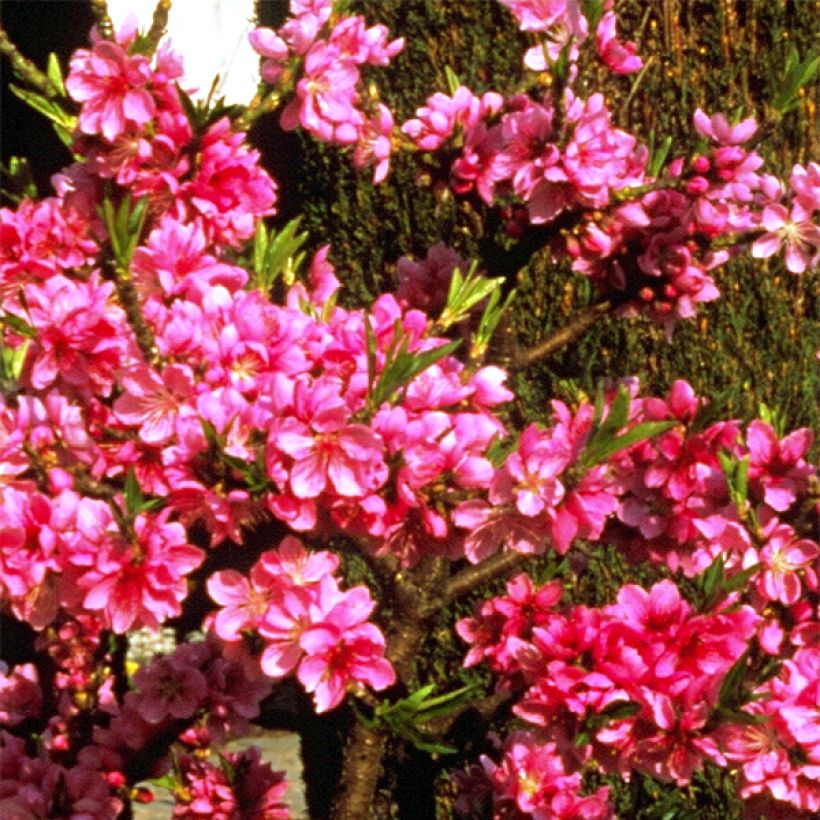





Plant habit
Fruit
Flowering
Foliage
Botanical data
Prunus
persica
Diamond® Zaipevi
Rosaceae
Peach, Peach tree
Cultivar or hybrid
Franc (Bare root - Scion)
Other Peach and Nectarine trees
View all →Planting and care
The Diamond® Zaipevi Dwarf Peach is preferably planted from October to December. Dig a hole two to three weeks before planting, twice as wide and deep as the pot. On the day, place the tree with its pot in a basin of water, to moisten the entire root ball by capillarity. Place compost at the bottom of the hole. Install the tree in the hole, fill with a mixture of soil and compost. Gently pack around the base of the fruit tree as you fill, the roots should be in close contact with the soil. The root ball should be completely covered. Water generously.
The Diamond® Zaipevi Dwarf Peach has a semi-pivoting root system. It will thrive in fairly deep soils. It also prefers a light and well-draining soil.
Planting period
Intended location
Care
Planting & care advice
-
, onOrder confirmed
Reply from on Promesse de fleurs
Similar products
Haven't found what you were looking for?
Hardiness is the lowest winter temperature a plant can endure without suffering serious damage or even dying. However, hardiness is affected by location (a sheltered area, such as a patio), protection (winter cover) and soil type (hardiness is improved by well-drained soil).

Photo Sharing Terms & Conditions
In order to encourage gardeners to interact and share their experiences, Promesse de fleurs offers various media enabling content to be uploaded onto its Site - in particular via the ‘Photo sharing’ module.
The User agrees to refrain from:
- Posting any content that is illegal, prejudicial, insulting, racist, inciteful to hatred, revisionist, contrary to public decency, that infringes on privacy or on the privacy rights of third parties, in particular the publicity rights of persons and goods, intellectual property rights, or the right to privacy.
- Submitting content on behalf of a third party;
- Impersonate the identity of a third party and/or publish any personal information about a third party;
In general, the User undertakes to refrain from any unethical behaviour.
All Content (in particular text, comments, files, images, photos, videos, creative works, etc.), which may be subject to property or intellectual property rights, image or other private rights, shall remain the property of the User, subject to the limited rights granted by the terms of the licence granted by Promesse de fleurs as stated below. Users are at liberty to publish or not to publish such Content on the Site, notably via the ‘Photo Sharing’ facility, and accept that this Content shall be made public and freely accessible, notably on the Internet.
Users further acknowledge, undertake to have ,and guarantee that they hold all necessary rights and permissions to publish such material on the Site, in particular with regard to the legislation in force pertaining to any privacy, property, intellectual property, image, or contractual rights, or rights of any other nature. By publishing such Content on the Site, Users acknowledge accepting full liability as publishers of the Content within the meaning of the law, and grant Promesse de fleurs, free of charge, an inclusive, worldwide licence for the said Content for the entire duration of its publication, including all reproduction, representation, up/downloading, displaying, performing, transmission, and storage rights.
Users also grant permission for their name to be linked to the Content and accept that this link may not always be made available.
By engaging in posting material, Users consent to their Content becoming automatically accessible on the Internet, in particular on other sites and/or blogs and/or web pages of the Promesse de fleurs site, including in particular social pages and the Promesse de fleurs catalogue.
Users may secure the removal of entrusted content free of charge by issuing a simple request via our contact form.
The flowering period indicated on our website applies to countries and regions located in USDA zone 8 (France, the United Kingdom, Ireland, the Netherlands, etc.)
It will vary according to where you live:
- In zones 9 to 10 (Italy, Spain, Greece, etc.), flowering will occur about 2 to 4 weeks earlier.
- In zones 6 to 7 (Germany, Poland, Slovenia, and lower mountainous regions), flowering will be delayed by 2 to 3 weeks.
- In zone 5 (Central Europe, Scandinavia), blooming will be delayed by 3 to 5 weeks.
In temperate climates, pruning of spring-flowering shrubs (forsythia, spireas, etc.) should be done just after flowering.
Pruning of summer-flowering shrubs (Indian Lilac, Perovskia, etc.) can be done in winter or spring.
In cold regions as well as with frost-sensitive plants, avoid pruning too early when severe frosts may still occur.
The planting period indicated on our website applies to countries and regions located in USDA zone 8 (France, United Kingdom, Ireland, Netherlands).
It will vary according to where you live:
- In Mediterranean zones (Marseille, Madrid, Milan, etc.), autumn and winter are the best planting periods.
- In continental zones (Strasbourg, Munich, Vienna, etc.), delay planting by 2 to 3 weeks in spring and bring it forward by 2 to 4 weeks in autumn.
- In mountainous regions (the Alps, Pyrenees, Carpathians, etc.), it is best to plant in late spring (May-June) or late summer (August-September).
The harvesting period indicated on our website applies to countries and regions in USDA zone 8 (France, England, Ireland, the Netherlands).
In colder areas (Scandinavia, Poland, Austria...) fruit and vegetable harvests are likely to be delayed by 3-4 weeks.
In warmer areas (Italy, Spain, Greece, etc.), harvesting will probably take place earlier, depending on weather conditions.
The sowing periods indicated on our website apply to countries and regions within USDA Zone 8 (France, UK, Ireland, Netherlands).
In colder areas (Scandinavia, Poland, Austria...), delay any outdoor sowing by 3-4 weeks, or sow under glass.
In warmer climes (Italy, Spain, Greece, etc.), bring outdoor sowing forward by a few weeks.































